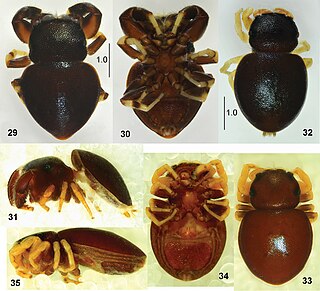
Tringa is a genus of waders, containing the shanks and tattlers. The genus name Tringa is the New Latin name given to the green sandpiper by the Italian naturalist Ulisse Aldrovandi in 1599. They are mainly freshwater birds, often with brightly coloured legs as reflected in the English names of six species, as well as the specific names of two of these and the green sandpiper. They are typically associated with northern hemisphere temperate regions for breeding. Some of this group—notably the green sandpiper—nest in trees, using the old nests of other birds, usually thrushes.

The lesser yellowlegs is a medium-sized shorebird. It breeds in the boreal forest region of North America.

The yellow-legged thrush is a songbird of northern and eastern South America and the Caribbean.

The scrub greenlet or scrub vireo is a small passerine bird in the vireo family. It breeds in Costa Rica, Panama, Colombia, Venezuela and Tobago. They can be found in the southernmost part of Central America and northern South America, which can be defined as extending from Venezuela to Colombia.

The yellow-billed spoonbill is a gregarious wading bird of the ibis and spoonbill family, Threskiornithidae. It is native to Australia, and is a vagrant to New Zealand, Lord Howe Island and Norfolk Island.

The yellow-footed antechinus, also known as the mardo, is a shrew-like marsupial found in Australia. One notable feature of the species is its sexual behavior. The male yellow-footed antechinus engages in such frenzied mating that its immune system becomes compromised, resulting in stress related death before it is one year old.

Reticulitermes flavipes, the eastern subterranean termite, is the most common termite found in North America. These termites are the most economically important wood destroying insects in the United States and are classified as pests. They feed on cellulose material such as the structural wood in buildings, wooden fixtures, paper, books, and cotton. A mature colony can range from 20,000 workers to as high as 5 million workers and the primary queen of the colony lays 5,000 to 10,000 eggs per year to add to this total.

The pale-footed swallow is a species of bird in the family Hirundinidae. It is found in the northern Andes, from Venezuela to Bolivia. It is monotypic.
The yellow-legged weaver is a species of bird in the family Ploceidae. It is endemic to Democratic Republic of the Congo.

The river clubtail or yellow-legged dragonfly is a species of dragonfly in the family Gomphidae. It is found in Europe. Its natural habitat are rivers and large streams. The dragonfly flies from June to September depending on the location.
Enchelyurus flavipes, the yellowfin blenny, is a species of combtooth blenny from the western Pacific Ocean. It occasionally makes its way into the aquarium trade.

The Parazinho Biological Reserve is a biological reserve in the state of Amapá, Brazil. It protects an island at the mouth of the Amazon River.
Condylostylus flavipes is a species in the family Dolichopodidae, in the order Diptera ("flies").
Pentagonica flavipes is a species of ground beetle in the family Carabidae. It is found in the Caribbean Sea, Central America, North America, and the Caribbean.
The common green tree skink is a species of skink. It is found in Papua New Guinea.

Pachyballus flavipes is a species of jumping spider in the genus Pachyballus found in Africa. Its distribution includes Angola, Botswana, Cameroon, Democratic Republic of the Congo, Equatorial Guinea, Ivory Coast, Kenya, South Africa, Tanzania, Uganda and Zimbabwe. The female was first described in 1909. The female was first described in 1941 under the name Pachyballus cordiformis. However, this was declared a synonym in 2020, along with Pachyballus flavipes aurantius.

Orochelidon is a genus of birds in the swallow family Hirundinidae. These species are resident in the Andes Mountains of South America.

Psiloscirtus apterus is a species of short-horned grasshopper in the family Acrididae. It is found in Ecuador and Peru.

Psiloscirtus bolivianus is a species of short-horned grasshopper in the family Acrididae. It is found in Bolovia.

Amanita flavipes is a species of Amanita found in oak and conifer forest of China, India, Japan, Pakistan, and South Korea.
















